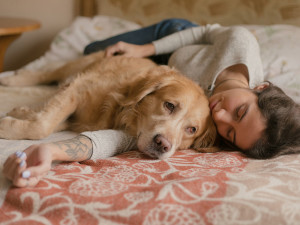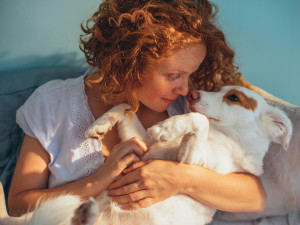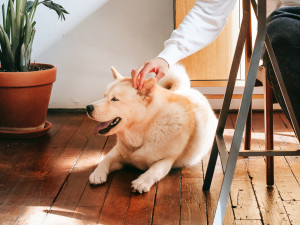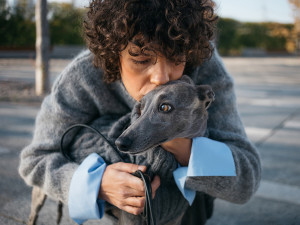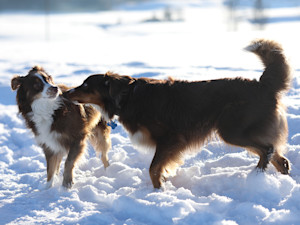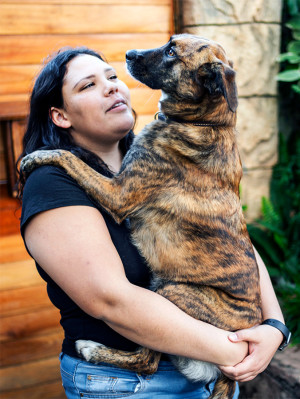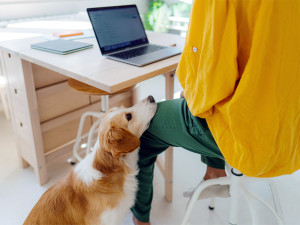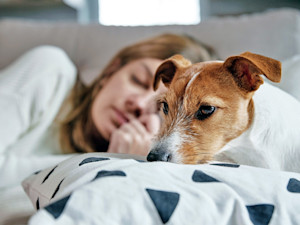4 Things You’re Doing That Really Stress Your Dog Out
Some may come as a surprise.
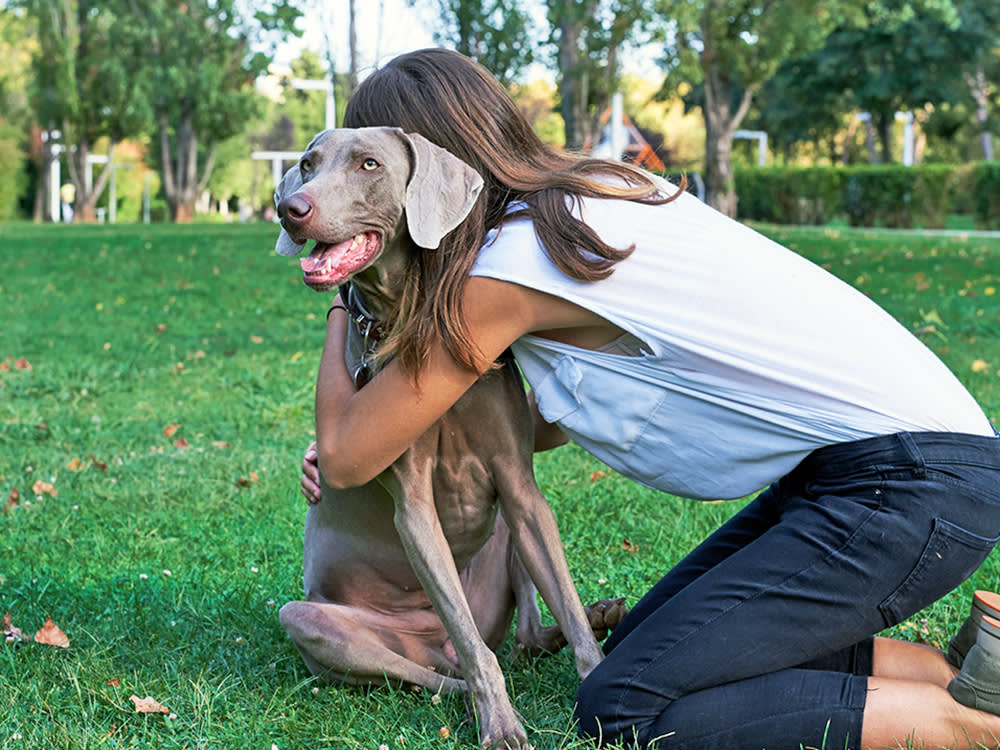
Share Article
Fireworks? Very scary, obviously. Thunderstorms? Not great. Big delivery trucks? Same deal. As a dog parent, you’ve probably identified a few things that clearly trigger a stress reaction in your pup. But some common sources of stress for our dogs may not be so obvious. How our dogs experience the world can be very different from our interpretations of the world, so some things we perceive as normal or inconsequential might actually be very stressful for our pets.
For your dog’s short-term happiness and long-term health, it’s important to understand what stresses your dog out and how to mitigate that anxiety. We spoke with Fanna Easter, a professional dog trainer and a member of the APDT Board of Directors, and veterinary behaviorist Dr. Margaret M. Duxbury about various ways you might be stressing out your dog without realizing it.
Common stress triggers for dogs
When we experience stress, it can impact our mood, behavior, and relationships. The same goes for dogs.
“None of us respond the best when we’re stressed,” Duxbury says. “We don’t bring our most rational selves to people or the environment…[Stress] sets the dog up not to do as well as they could.”

When dogs experience stress — especially “trigger stacking,” or when multiple stressful or scary events “stack” on each other in a short period of time — it can cause them to act out, sometimes with uncharacteristic aggression, such as snapping or biting.
It’s important to learn to recognize stress in your dog and know when it is necessary to take action to reduce that stress. Here are some things that might be stressing your dog out more than you expect:
New people or pets
Dogs have independent emotional lives, Duxbury says, and they form their own unique relationships with different people and pets. Just because someone is your best friend, doesn’t mean they’re your dog’s best friend, too.
Sometimes, the new person in your home is a baby or child. Even if your dog tolerates a newborn well, their stress levels might rocket when that toddler becomes mobile. Duxbury advises taking things slow and gradually acclimatizing your dog to a new babyopens in new tab, friend, or animal in the household.
The same rules apply when you’re out in public. Easter notes that people often insist on petting dogs they see — whether they know that dog or not. This can be especially stressful for more reserved dogs.
“If your dog doesn’t want to be pet,” Easter says. “Ask (insist if needed) a person to ignore your dog and stand six feet away.”
Mixed-signal training
What might seem like a clear cue to us (“sit!”) might not be so obvious for our dogs.
“People really underestimate how dogs read people,” Duxbury says. “Just minute changes in your posture… affect the quality of signal or cue you’re giving the dog.”
In other words, if the cue you’re giving (i.e., “Come!”) and body language (i.e., stern voice, aggressive posture) don’t match, it might confuse your dog. Duxbury, who advocates for reward-based training, says the same is true when you respond authoritatively when your dog does something wrong. Correction-based training doesn’t provide your dog with enough information on what they did wrong or how they should react instead, she says, which can also cause stress.
Walks
While taking your dog for a walk is generally good for their healthopens in new tab, there are a few exceptions. For example, Easter says you should never force your dog to go on a walk if they appear stressed. If your dog pulls to go home, barks at other dogs, and/or displays other anxious behavior, listen to their needs and return home, she advises.
Walking by barking dogs can also be extremely stressful. “No one wants to walk near someone screaming obscenities toward them, so why do we insist dogs should walk near dogs barking aggressively at them?” Easter says. “Change directions, and avoid that spot in the future.”
Overestimating how social your dog wants to be
While you might want to include your dog in all your fun weekend plans, our experts say it's best to consider what the experience really might be like for your dog. Duxbury says crowded locations such as farmers’ markets or breweries can be extremely stressful for all except the most social dogs. “They’re just looking at kneecaps and feet coming at them,” Duxbury adds. If you want to bring your dog to a brewery, try less crowded days and times, or sit on the periphery where it’s less busy.
The same goes for dog-oriented events and locations, such as dog parks. “There are huge expectations that your dog will be social with a bunch of other dogs they’ve never met,” Duxbury says. “Some dogs are. But some dogs aren’t, and they don’t bring their best selves to the dog park because it’s stressful.”
How to recognize stress in your dog
The first step to supporting your dog is to learn how to recognize when your dog is starting to feel anxious or overwhelmed. The key here is to pay close attention to your dog’s body language. Here are a few signs to look out for that might indicate your dog is feeling stressed:
Excessive yawning, panting, or lip licking
Whale eye — when you see the whites of your dog’s eye
Looking away
Pacing
Cowering, trembling, or backing away from a situation
Pay attention to whether your dog’s stress is building. If it is, take action to mitigate your their anxiety so they don’t feel the need to act out. There are also several resourcesopens in new tab out thereopens in new tab that can help you identify body language in your dog that shows they are not OK.
Create a stress-free zone
There is no one-size-fits-all solution to relieving anxiety for dogs. However, there are several things you can do to make your home feel like a safe space. Consider the following:
Follow positive reinforcement trainingopens in new tab: Both of our experts recommend seeking out a positive reinforcement behavior consultantopens in new tab or traineropens in new tab. “Many [pet] guardians focus on symptoms (barking, hiding, hyperactivity) as a stressor when anxiety is usually the main cause,” Easter says. “Expert help is needed to clearly define the cause for anxiety and how to address the issue.”
Give your dog a safe space and comfy bed: If your dog doesn’t get along well with strangers, make sure they have a safe place in your bedroom to relax with food, water, and toys. If your dog isn’t allowed on your bed or furniture, Duxbury says to make sure your dog bed passes the �“princess and the pea” test: If you pinch your dog bed and can feel your fingers rubbing together, then it’s too thin.
Consider a sound machine: Placing a sound machine where scary noises happen, like near the front door or a busy window, can make all the difference. “Music and TV have ebbs and flows,” Easter says. “Dogs can hear sound during these tiny moments.”
Make sure you’re meeting your dog’s daily needs: If you’ve ever been hangry or had a poor night of sleep, you know how important it is to keep a regular schedule. Do your best to feed and walk your dog following a consistent routine.
Be a partner your dog can rely on
The next time your dog misbehaves, consider the context and your environment. “Stress is real in dogs,” Easter says. “Remember, dogs are not acting out, they’re struggling. Help them, and listen to their needs.”
Duxbury agrees, emphasizing that part of our duty as dog parents is to care for the emotional and mental well-being of our pets. “So much depends on trust and being able to count on your partner,” she says. “It’s really you and your dog against the world.”
Resources:

Sarah (Kollmorgen) Cottone
Sarah is a writer whose work has appeared in The Atlantic, Discover magazine, and HuffPost among other places. She lives outside of Denver with her husband and their dog, Lucy, who is the true queen of the household.
Related articles
![Two Australian Shepherd dogs meeting in the snow]()
Are Your Dogs Arguing With Each Other?
How to tell the difference between dog aggression and communication.
![Russian Toy Terrier with ears back]()
9 Reasons Why Dogs Put Their Ears Back
Here’s how your dog’s ears can clue you in to how they’re feeling.
![Pet parent comforting anxious dog by holding their paw]()
How to Help an Anxious Dog
Easy ways to calm your pup’s nerves.
![Young woman holding her large dog in her arms outdoors.]()
What to Do When Your Dog Is Even More Anxious Than You Are
Did you get a dog for emotional support and now they are the one who needs it?
How to Help Your Dog Be Just a Little Less Needy
You love that your dog is your shadow, but maybe not when you’re on a Zoom call.
![Tired millennial woman sleeps on sofa with her dog.]()
Dogs Stay Up Worrying at Night Too, Study Says
It may happen more when there stressful events like fireworks.
